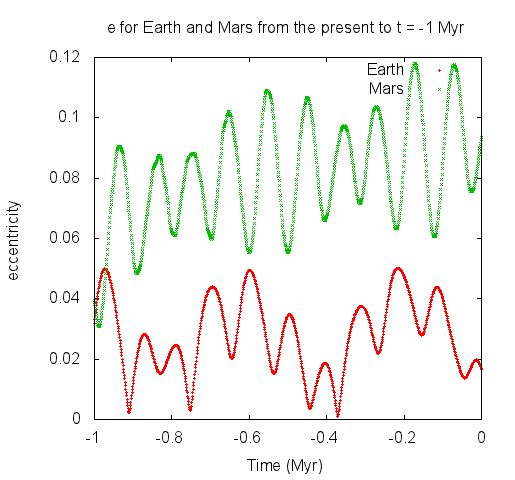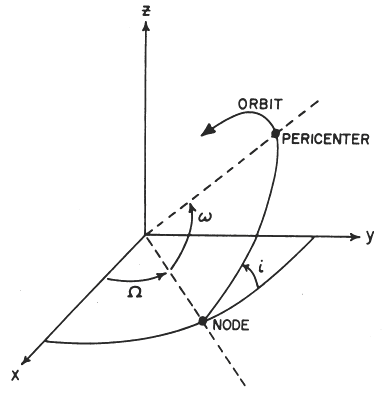3) THIRD STEP: analyze orbeout.dat
Here is an extract of the file orbeout.dat
-5.000000E+05 1 0.387099 0.213741 8.10 70.56 24.99 288.30
-5.000000E+05 2 0.723323 0.017668 4.00 107.96 124.98 103.19
-5.000000E+05 3 1.000012 0.034443 1.24 91.78 88.26 79.11
-5.000000E+05 4 1.523737 0.055313 5.03 180.79 162.97 48.72
-5.000000E+05 5 5.203247 0.027860 1.60 97.19 53.54 268.17
-5.000000E+05 6 9.513984 0.079794 2.05 135.20 26.11 70.25
-5.000000E+05 7 19.249354 0.059683 1.84 73.28 297.28 343.09
-5.000000E+05 8 30.125651 0.005854 0.92 105.64 218.39 171.68
time planet a e i node w M
This extract corresponds to the state of the system at t=-500000 yrs.
Using your favorite program plot the orbital elements as funtion of the time.
We recommend gnuplot. Excel is not a good tool
for plotting scientific data.
Here is the script of gnuplot used to generate the figure:
set terminal png
set output "orbe2.png"
set size 0.8, 1
set title "e for Earth and Mars from the present to t = -1 Myr"
set xlabel "Time (Myr)"
set ylabel "eccentricity"
p [-1:0][] "orbeout.dat" u ($1/1e6):($2==3 ? $4 : 1/0) w p ps 0.2 title "Earth" , \
"orbeout.dat" u ($1/1e6):($2==4 ? $4 : 1/0) w p ps 0.2 title "Mars"
and this simple script shows in the screen a,e,i,nodes,w:
p [][] "orbeout.dat" u 1:3 w p ps 0.1
pause -1
p [][] "orbeout.dat" u 1:4 w p ps 0.1
pause -1
p [][] "orbeout.dat" u 1:5 w p ps 0.1
pause -1
p [][] "orbeout.dat" u 1:6 w p ps 0.1
pause -1
p [][] "orbeout.dat" u 1:7 w p ps 0.1
pause -1
At present (t=0) Mars' eccentricity (e=0.093) is larger than Earth's eccentricity (e=0.016). But in the past (t=-950000 yrs) the Earth
was more eccentric than Mars. Both e(t) seems to be the addition of some periodic terms, try to obtain the spectrum of them. Plotting e(t)
is just the beginning, try to plot other elements and for all planets.
|

|


